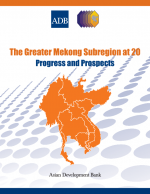The Greater Mekong Subregion at 20: Progress and Prospects

The Greater Mekong Subregion (GMS) includes Cambodia, the People's Republic of China (specifically Yunnan Province and Guangxi Zhuang Autonomous Region), the Lao People's Democratic Republic, Myanmar, Thailand, and Viet Nam. In 1992, with assistance from the Asian Development Bank (ADB) and building on their shared histories and cultures, the six countries launched a program of subregional economic cooperation - the GMS Program.
Over the past 20 years, the GMS Program has achieved substantial success in improving regional connectivity through investments of $15 billion as well as more than 180 technical assistance projects. With support of ADB and other development partners, the program is helping the participating countries achieve the Millennium Development Goals and balanced growth through increased connectivity, improved competitiveness, and a greater sense of community.
Taking into account the challenges and opportunities that lie ahead for the GMS and the 20 years of achievements of the GMS Program, leaders of the GMS countries adopted a new strategic framework at the Fourth GMS Summit in 2011 to guide the program over the coming decade. The framework and the future program will focus on a broad range of sector and multisector issues as follows:
Download |
The Greater Mekong Subregion at 20: Progress and Prospects |
Last Updated: Monday, 3 December 2012
